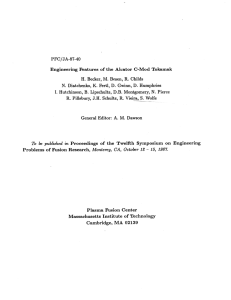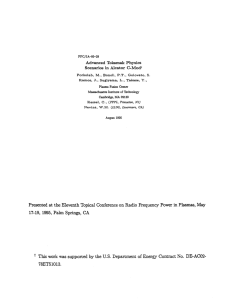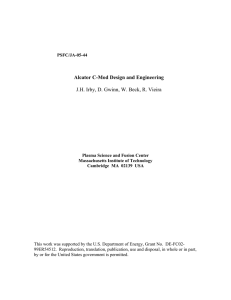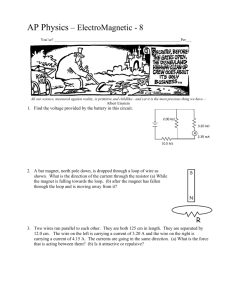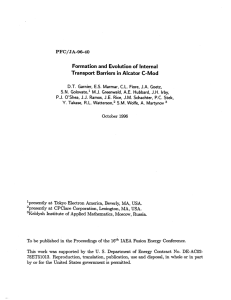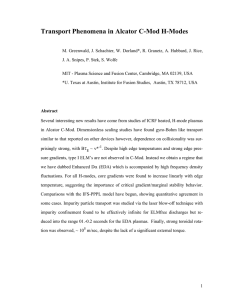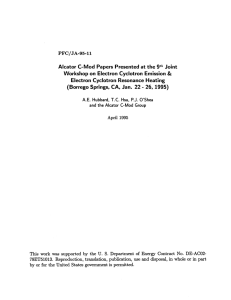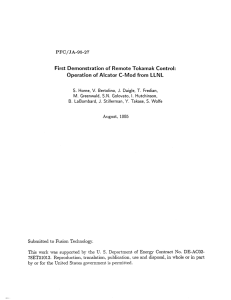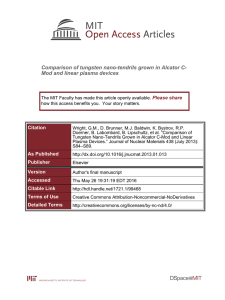PFC-JA/86-40 D. J.H. Sliding Joint and Bond Development ...
advertisement
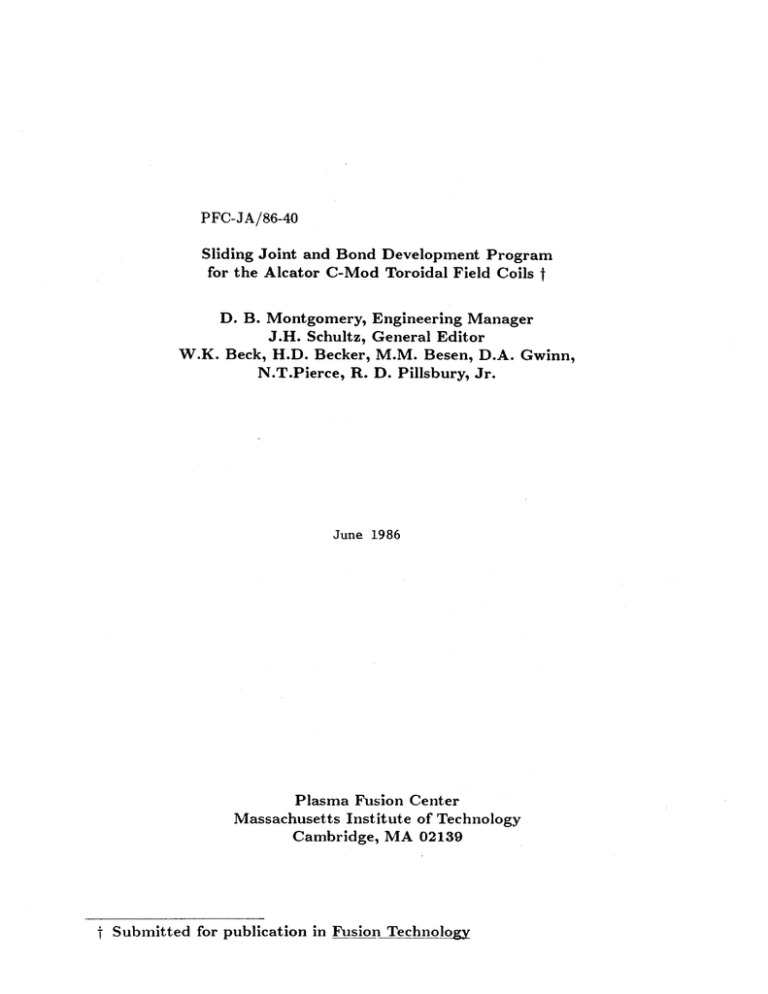
PFC-JA/86-40
Sliding Joint and Bond Development Program
for the Alcator C-Mod Toroidal Field Coils f
D. B. Montgomery, Engineering Manager
J.H. Schultz, General Editor
W.K. Beck, H.D. Becker, M.M. Besen, D.A. Gwinn,
N.T.Pierce, R. D. Pillsbury, Jr.
June 1986
Plasma Fusion Center
Massachusetts Institute of Technology
Cambridge, MA 02139
t
Submitted for publication in Fusion Technology
Sliding Joint and Bond Development Program
for the Alcator C-Mod Toroidal Field Coils
Abstract
The Alcator C-Mod toroidal field (TF) magnets include several advanced magnet concepts
that are planned or considered for a compact ignition tokamak experiment (C.I. T). Two
concepts in particular, sliding joints and explosively-bonded composite plates, require a
development program to assure feasibility and performance.
Introduction
Alcator C-Mod is an upgrade of the Alcator C tokamak at M.I.T. with the mission
of investigating ICRF-heated plasmas at the high fields and densities most relevant to
a compact tokamak ignition experiment.' An elevation view of the machine, showing its
rectangular TF magnet and vacuum vessel and its internal poloidal field coils is shown in
Figure 1. Major dimensions and performance goals of Alcator C-Mod are shown in Table I.
The toroidal magnet system in C-Mod is required to be both high performance and flexible,
in order to allow experiments over a broad range of plasma fields and shapes. These goals
define a unique set, of engineering problems, described previously by the authors. 2 The
most challenging requirement is to develop a toroidal magnet that is sinmiultaneoulsy highfield and high strength, but that can be disassembled. in order to install internal poloidal
field coils and a single-piece vacuum vessel. The solution to this challenge requires the
development of sliding joints and bonded plates in the TF magnet.
The Alcator C-Mod TF magnet is fabricated in 20 picture-frame coils, each coil consisting of four stacks of 6 conducting plates. The stacks form the vertical and horizontal
sides of the frame and are connected by sliding joints at the corners. The inner legs are assembled in a central TF cylinder, consisting of 120 copper-Inconel laminate tapered plates.
The plates are wedged together into a homogeneous cylinder, with thin epoxy-fiberglass
sheets between them. The central cylinder is in the highest field and most highly stressed
region of the tokamak. The maximum field at the TF magnet is 20 T. In order to remain within stress allowables, the inner leg requires both removal of tension and bending
through the sliding joints and composite bonding of copper to high strength reinforcement.
Sliding Joints
The benefits of sliding joints in tokamak TF magnets have been described previously
by Puhn.3 These include flexibility in the assembly of the vacuum vessel and internal
poloidal field coils and elimination of bending and vertical forces on the TF inside column.
Sliding joints using multilaminates have been tested successfully at General Atomic for 3
seconds, up to a burnout current density of at least 4 kA/cm2 for small multilaminates
with a compression range of 0.3 mm .4
1
r
, ---i
--..
1.
- ...-. .
.L
:1
0
/
/
141
I
-
K
103
/
a'
--
-~
-
-9-
I01)
"A
a
z
Hd
4
III
/
{
Ti
- Io
-----------I-
- --
/
A-A
5
IS
10
IS
20
30
q0
C".
Fig. 1. Elevation View of Alcator C-Mod.
2
20
INCHE$
50
25
ble I
Alcator C-Mod Machine Parameters
Parameter
Value
R,,
0.64
0.21
9.5
1.8
0.3
aminor
Bt
Elongation
Triangularity
IP
tf lattop
PF flux-swing
RF Heating
3.5
1
9
6
Units
(mn)
(mn)
(T)
(MA)
(s)
(V-s)
(MW)
Table II
Inside TF Joint Stress and Displacement
R 0 - R,
P face,av
0
50
138
41.4
70.9
Obend
7shear
25
413
30
3
75
(mm)
62
32.3
2.1
(kPa)
(MPa)
(MPa)
Joint Concept
Each leg of the TF coil is made up of a rectangular plate, joined along a broad mating
surface to orthogonal plates on either end. The currently favored topology of the joint
itself is mortise-and-tenon. A lap joint has also been analyzed and tested. Pressure and
displacement on the joint are controlled by a dimpled spring plate in the center of each
joint, as illustrated in Figure 2. At the operating point, the dimples exert a pressure of 250
psi over plates with a width of 76.2 mm and a length of 241 mm. Each dimple can travel
0.838 mm from the undeflected to the bottomed position. In order to exert 250 psi of
pressure over the face, the inserted position of the dimples is 0.25 mm from the bottomed
position.
Structural Analysis
The structural requirements of the joint are to stay within allowable stresses in the
joint, region and to limit deflections within a range that allows adequate electrical contact
but still permits sliding to relieve vertical forces in the inner TF leg. The dominant forces
on the joint are Lorentz forces. In-plane forces have been decomposed into wedging and
bucking in the joint region. Although a 5 cm radial extent of the joint was adequate
from electrical and thermal considerations, the joint width was extended to 7.6 cm, in
order to allow wedging of the radially inward force on the horizontal arms, if necessary.
The out-of-plane forces on the joint were examined at several points in time in order to
find the worst cases. The worst-case stresses usually occurred immediately before plasma
initiation. Out-of-plane stresses are due to pressure on over the face of the joint, bending of
the fingers about their horizontal and vertical axes, and the relative twist of the horizontal
arms and the central cylinder. The bending due to differential twist was the dominant
source of bending stress, using a simplified model, in which torsion in the horizontal arms
and central cylinder were computed separately. When a more sophisticated model included
the torsion applied on the inner cylinder by the horizontal arms through the joints. relative
displacements were reduced by greater than a factor of two. A potted intercoil structure
was also added to the structure to reduce the twist of the horizontal arms. With these
improvements in design and analysis. the stresses and displacements in the joint were
calculated to be within allowable limits. The results of the analysis for the lap joint are
shown in Table II.
Thermal and Electrical Analysis
The current density capabilities of the joint depend on detailed finite element analysis,
because the inertial cooling of the joint depends on both thermal and magnetic diffusion.
A detailed finite element analysis has been performed for the most demanding TF magnet
scenario, a 1 s flattop at 9 s. (The TF coils are designed for structural adequacy at
10 T,
while the most demanding experiment being planned requires 9 T for 1 s.) The model used
includes thermal and magnetic diffusion with temperature-dependent properties. regulation
and speed reduction of the pulsed generator-rectifier supply and detailed
4
000
0 00
0 00
0 0
o
0
000
Ono
0
0 0 I-W 0
00
o.OOL
F(,,
o o0
0000
0
0
0
00
0
I
C)
C
0
0
o
ju
ju
.....
..
.....
..
...
.....
"I'll
.... ,",
.....
..................
......
.......
.....
. . .....
11
Fig. 2. Detail of inner TF joint showing dimpled spring plates.
57
current constriction in the four joint regions. Surface resistivity is not included due to
modelling difficulties. Joint specifications have been set so that current constriction must
be the dominant cause of joint losses. With this model, the peak hot-spot temperature at
the inside corner of the joint is 276, occurring at the end of the TF flattop, as shown in
Figure 3. Extremely high transient, local current densities exist in the inside corner of the
joint, early in the pulse when the largest skin currents are flowing through the
TF plates,
but the current densities and temperature rises are broadened considerably by the end of a
pulse. For a specific TF ramp scenario, the specification of average and peak instantaneous
current, densities through the inside joints are shown in Table III.
Joint Dissipation
The local Joule heating in the joint region is higher than that in the bulk conductor
because of two effects: current constriction and the surface resistance of the joint. In
the joint region, each half of the joint must carry the entire conductor current through a
reduced cross section. As current enters the joint region, before any current stream lines
have crossed the joint, the local current density is double that in the bulk conductor. The
joint, itself consists of a coating with resistivity considerably higher than that of copper and
also consists microscopically of matching ridges and valleys with imperfect contact. This
effect is usually defined in terms of an equivalent surface resistivity of the joint. A code
has been developed to evaluate the total steady-state dissipation in a joint region with a
fixed surface resistivity. This code was used to analyse the lap joint evaluated in the 1985
Alcator C-Mod proposal, parametrically varying the surface resistance of the joint. The
results are shown in Figure 4. At room temperature, the surface resistance of the joint is
a second-order effect over a broad range of practical resistances, out to an inflection point
of 150 pQ-cm2 , at which the total dissipation is doubled. For the Alcator C-Mod there is
a further broadening effect of magnetic diffusion, in that higher surface resistance will lead
to faster diffusion and broader current profiles over the course of a pulse. A specification
of 30 pQ - cm 2 was developed in order to avoid unnecessary heating of the joint region.
Small-scale Joint Tests
A large number of tests of resistance v-. mechanical cycles have been performed on
4 cm 2 square tests samples with a variety of surface preparations. In each test. surface
resist ance was measured before and after a number of mechanical cycles. Each mechanical
cycle was designed to simulate the actual mechanical cycle at the joint. Typically 200 psi
was applied to the sample., and the sample was moved 5 mm with respect to its mating
surface. This corresponds to the predicted vertical displacement of the coil horizontal arms
during a 10 T discharge.
The best overall mechanical-electrical performance has been exhibited by the Ag-AgW
contact, while the best performing lubricant, has been Penetrox A, which has been used
successfully at M.I.T. for busbar connections. Selected test results are shown in Table IV.
Ag-Ag has the best static performance, but exhibits both galling and significant
6
1.5
-r
I
I
I
S
.
I
.
I
I
.
I
I
1.4
1.3
1. 2
1. 1
1.0
.9
ll
-10K
K
-----
2
.7
60K
.6
.5
.4
.3
.2
.1
-200 K
on
0.
.3
.6
.9
R
mi
Fig. 3. TF magnet temperature contours.
7
1.2
1.5
100 1
80 -f
..
....
....
60
.5
40
-
20
.
,
0
200
400
600
Surface Resistivity (lAt
800
-
cm 2 )
Fig. 4. Specific joint loss (MW) vs. joint surface resistivity (pl - m 2 ).
8
1000
Table III
TF Joint Requirements
Parameter
Description
Value
Icond, (kA)
Ajoint, (cm 2 )
Aerfry, (cm 2 )
joint current
total joint area
total cross section into joint
average current density through joint
peak current, density through joint
average current density into joint
peak current density into joint
267
252
14.5
1.06
15
18.4
60
(kA/cm 2 )
Jjoint,peak, (kA/cm 2 )
Jcond,av, (kA/cm2 )
Jcond,peak, (kA/cm 2 )
Jjoini,av,
Table IV
Small Scale Joint Resistivity Test Results
Surface Types
No. Cycles
Psarface
P surface
(300 K)
(psi)
(PQ - cm
7.3
16
5.6
Ag vs. Ag
Ag vs. Ag
Mo vs. Ag
BeCu Multilams
static
3,000
40 % Ag-60 % W vs. Ag
static
13,000
178
100
500
57
(GA: 65.6)
250
250
static
10,000
200
200
Ag vs. Ag
with Penetrox A
1,500
static
9
202
(GA: 50)
(80 K)
2
yQ - cm 2
2.2
60
40
160
13
5.2
degradation of surface resistance after a few thousand cycles. A variety of tests on Mo vs.
Ag indicate that it is limited to a surface resistivity of no better than 30-40 pQ - cm 2 .
This is marginal with respect to C-Mod's joint specifications, but is nondominant when
compared with current constriction. The superb performance of 40 % Ag - 60 % W vs.
Ag, approaching the static resistivity of pure silver with no degradation in 10,000 cycles
seemed to make it the surface preparation of choice. However, the results of the small scale
tests have not yet been duplicated on the full-scale joints.
A more conservative approach to concerns that the small-scale test is not a complete
simulation of mechanical wear is to use a lubricant at the joint. Two lubricants have
been tested, Krytox and Penetrox. Krytox had been used successfully in the Westinghouse
joint, concept tested at Princeton for CIT. However, in small-scale tests at M.I.T. the
performance of Penetrox A was far superior, both in the absolute value of surface resistivity,
repeatability, and avoidance of a tendency to clump at cryogenic temperatures. Again, the
results of the small- scale tests have not yet been duplicated on the full-scale joints. The
major concern is whether the joint is achieving adequate contact area over a broad surface.
Full-Scale Joint Tests
A full-scale segment of a set of joints in the inner corner has been constructed, consisting of 7 lower arms and 7 tapered partial-length inner cylinder turns. This corresponds
to one coil in the originally proposed Alcator C-Mod machine. The stack of horizontal
plates for the lap joint test is shown in Figure 5, illustrating the bends and tapers needed
in the joint region. A top view of the assembled joint is shown in Figure 6. The joints
are spring-plate loaded to 275 psi. Both mechanical and electrical tests have been carried out on different joint concepts. The two different topologies that have been tested
are a lap joint and mortise-and-tenon joint. Either concept may be acceptable, but the
mortise-and-tenon is favored because of the increased contact surface and the absence of a
net out-of-plane force, due to the current transfer. In the mechanical tests, a motor-driven
jack screw drives the horizontal arms over a cyclical vertical travel of 5 mm, corresponding
to the predicted displacement of the arms. The test frame and assembly for the mechanical
tests are shown in Figure 7. One turn of the seven-turn assembly has also been run up to
150 kA for a. one second pulse. Mechanical and electrical tests have also been performed
simultaneously. Full mechanical and electrical qualification of a joint concept has not yet
been achieved.
Bond Development
A bond between high-conductivity copper and a high-strength material, such as Inconel
718, can produce a better combination of structural, electrical and thermal properties
than any individual copper alloy. This technique has also been adopted for the Compact
Ignition Tokamak, in order to minimize the size of an ignition experiment. Both projects
are experimenting with explosive bonding, a new technique for fabricating high-strength
composites.
10
*
>4
>4
>4
>4
*
'U
4>44
44>
>>
44>4
>4)4
-,
4
>44
4
<>><
>'
44<
>4
>4
>4
>4%
>44>5<>
44>4
,S>
it
4>>
>4>
4<>
2
S
44
4r>>4>
4<,
*
>4
>4
U)U)
<4<,
-
U)
4)
4
-~
4)
(~)
U)
I-
k
C
(4
-4-3
U)
4)
4>44>,>
...*4
11i
<
4<
<
><
.5
4)
4>,
S
V
10
(I)
*
C
4
4
4)
,4>
'4
i/i
C
.4
4,
r
'4
4
44
4
4<
<>4
"'4"
I'
4<
'4'.
>4'
12
'4'
'4
<'>4)4 '>
'4
'4
<'4
r
4
4,
4
444
Cr
Cr
'4
0)
* K,
kK.
44
.5
0
kc)
C~)
~1
-
1<
444
44444
Cs
S
0)
Cr
Cr
-e
F,
C-
Cr
0)
H
1-
13
Alcator C-Mod is designed to remain within allowable stress limits up to a central field
of 10 T. This requires the addition of 20 % Inconel 718 to a composite which also includes
80 % OFE copper and 30 mil fiberglass-epoxy insulating sheets. The present thicknesses of
the sheets in the inside TF leg are shown in Table V. Inplane stresses have been calculated,
as shown in Table VI. Since the average Tresca stress in the inner cylinder is above the
yield of copper, the addition of a reinforcing material is necessary. The stresses show the
need for about 20 % steel.
Bond Structural Behavior
Lorentz loads on the magnet are generated in the copper and must be transferred to the
reinforcement through the bond. Two bonded materials in tension have equal strain and
therefore share the load according to the ratios of the Young's modulus of the materials. It
has not been generally understood, until recently, that two bonded materials in compression
will also have equal strain if the aspect ratio of the two structures being compressed
together is sufficiently large, because extrusion of the softer material is prevented by shear
at the interface. A theoretical justification of this design approach, along with test results
on stacks of copper-Inconel samples in compression have been reported by Becker.5 Since
the minimum aspect ratio of the composite plates is greater than 10, the high aspect ratio
approximation applies and the inner cylinder would not be expected to fail, even if the the
copper plates were in yield.
Bond Fabrication
High quality explosive bonds in plates with sizes typical of TF inner legs have been
achieved previously in copper-Inconel composites. High quality bonds with low surface
ripple were developed as part of the CIT R&D program. Mechanical tests on the CIT
bonded plates indicated that the high aspect ratio approximations for composite strength
were accurate. The plates for CIT have twice the thickness of those for Alcator C-Mod
and twice the fraction of reinforcement. Since explosive bonds are believed to be more
difficult to achieve for thin reinforcements, the bond for Alcator C-Mod has proven to be
more difficult for the original explosive fabricator. A second fabricator has succeeded in
achieving an explosive bond with the specified thicknesses of copper and reinforcement,
and has been asked to demonstrate a bond on a full-width plate sandwich.
Conclusions
The joint and bond development programs for Alcator C-Mod have not been completed, but several important milestones of the program have been achieved:
e Joint surface preparations, with and without lubricant, have been developed with
adequate electrical and mechanical properties in small sample tests.
* A full-scale joint test stand has been constructed, along with full-scale details of
14
Table V
Bonded Plate Dimensions - TF Inside Leg
Parameter
Description
Value
Ri, (mm)
R0 , (mm)
smaller radius, inner leg
larger radius, inner leg
reinforcement thickness
insulation thickness
least conductor thickness
greatest conductor thickness
reinforcement fraction in metal
108
310
2.2
0.76
5.76
16.2
0.2
t.. (mm)
tins, (mm)
ti,cond, (mm)
tocu, (mm)
fl.
Table VI
In-plane Stresses in the TF Central Cylinder at 10 T
St resses
Description
Value
(MPa)
average toroidal stress
average tensile stress
(7z,av
(7Tresco,aov average Tresca stress
OFE copper yield stress. RT
Inconel 718 yield stress, RT
laminate yield. 20% Cu. 80% Inconel
SF
Average Tresca allowable stress
'1 s ,a V
15
-325
45
370
308
1.218
463
0.94
two candidate joint concepts. The stand has been cooled to liquid nitrogen temperature,
joints have been operated up to full joint current density and plate stacks have been
mechanically cycled at design values of joint pressure and vertical displacement.
9 Analysis tools have been developed that predict the structural, electrical and thermal
adequacy of the sliding joints.
9 A bonded composite has been designed that is predicted to be structurally adequate at high fields. Small sample composite stack tests have confirmed bond behavior in
compression.
* A low ripple bond has been achieved on a small composite bar with the design
thicknesses of copper and reinforcement.
16
Acknowledgments
We would like to thank E. Thibeault and the M.I.T. Reactor machine shop for the
fabrication of the bent plates for the full-scale joint tests, and A.M. Dawson for the preparation of this manuscript.
References
1 R. Parker et al, "Alcator C-Mod Proposal: Addendum," proposal by M.I.T. Plasma
Fusion Center, April 1986.
2 J.H. Schultz, H. Becker, K. Fertl, D. Gwinn, D.B. Montgomery, N. Pierce, R.D. Pillsbury, and R.J. Thome, "Conceptual design of the Alcator C-Mod magnetic systems,"
11th Symp on Eng Probs of Fus Research, Austin TX, Nov 1985.
3 F. Puhn, et al, "Mechanical design of a high-beta TFCX tokamak with a demountable
TF coil," presented at the Thirteenth Symposium on Fusion Technology, Varese, Italy,
Sept. 24-28, 1984.
4 F.A. Puhn and J.M. Strohmayer, "Design and testing of a sliding joint. for a high
performance toroidal field coil," GA Technologies Report GA-A18210, Nov 1985.
5 H. Becker et al, "Structural properties of reinforced copper," M.I.T. Plasma Fusion
Center Report PFC/RR-86-12, May 1986.
17
